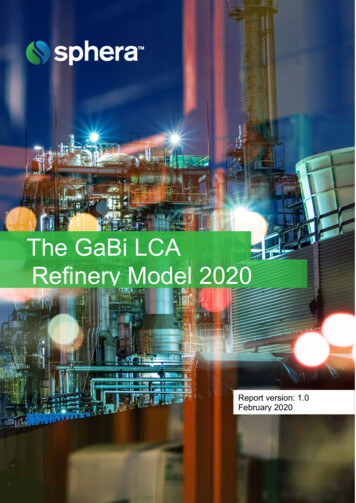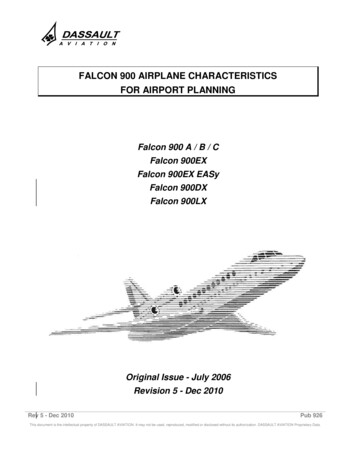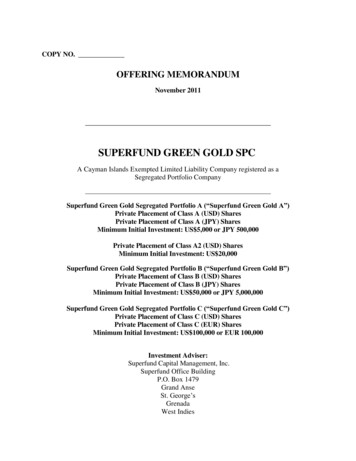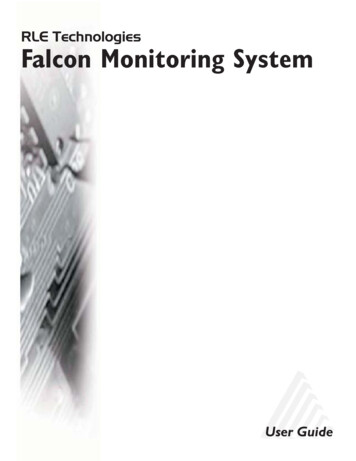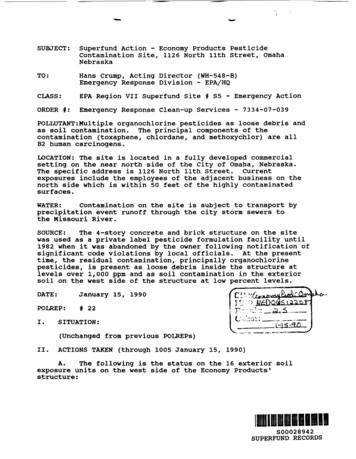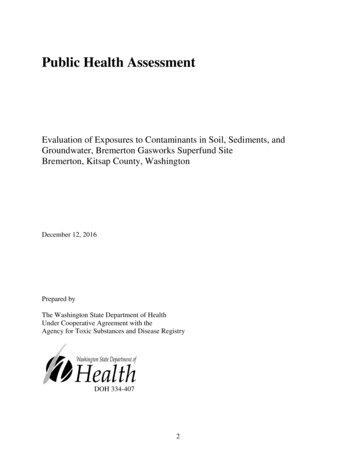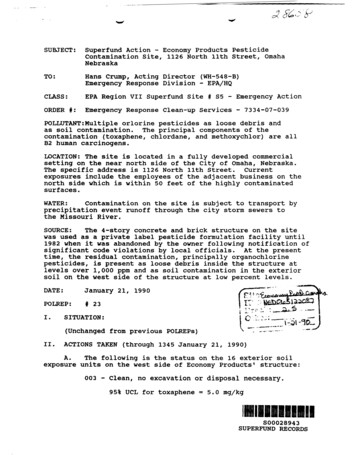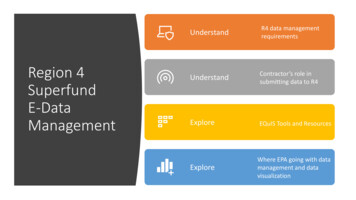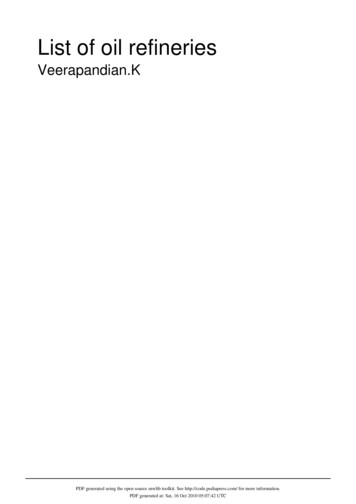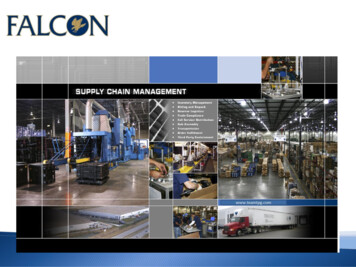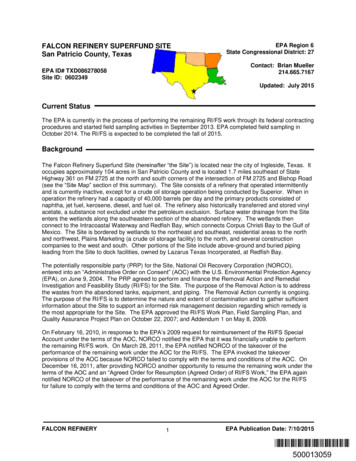
Transcription
FALCON REFINERY SUPERFUND SITESan Patricio County, TexasEPA Region 6State Congressional District: 27Contact: Brian Mueller214.665.7167EPA ID# TXD086278058Site ID: 0602349Updated: July 2015Current StatusThe EPA is currently in the process of performing the remaining RI/FS work through its federal contractingprocedures and started field sampling activities in September 2013. EPA completed field sampling inOctober 2014. The RI/FS is expected to be completed the fall of 2015.BackgroundThe Falcon Refinery Superfund Site (hereinafter “the Site”) is located near the city of Ingleside, Texas. Itoccupies approximately 104 acres in San Patricio County and is located 1.7 miles southeast of StateHighway 361 on FM 2725 at the north and south corners of the intersection of FM 2725 and Bishop Road(see the “Site Map” section of this summary). The Site consists of a refinery that operated intermittentlyand is currently inactive, except for a crude oil storage operation being conducted by Superior. When inoperation the refinery had a capacity of 40,000 barrels per day and the primary products consisted ofnaphtha, jet fuel, kerosene, diesel, and fuel oil. The refinery also historically transferred and stored vinylacetate, a substance not excluded under the petroleum exclusion. Surface water drainage from the Siteenters the wetlands along the southeastern section of the abandoned refinery. The wetlands thenconnect to the Intracoastal Waterway and Redfish Bay, which connects Corpus Christi Bay to the Gulf ofMexico. The Site is bordered by wetlands to the northeast and southeast, residential areas to the northand northwest, Plains Marketing (a crude oil storage facility) to the north, and several constructioncompanies to the west and south. Other portions of the Site include above-ground and buried pipingleading from the Site to dock facilities, owned by Lazarus Texas Incorporated, at Redfish Bay.The potentially responsible party (PRP) for the Site, National Oil Recovery Corporation (NORCO),entered into an “Administrative Order on Consent” (AOC) with the U.S. Environmental Protection Agency(EPA), on June 9, 2004. The PRP agreed to perform and finance the Removal Action and RemedialInvestigation and Feasibility Study (RI/FS) for the Site. The purpose of the Removal Action is to addressthe wastes from the abandoned tanks, equipment, and piping. The Removal Action currently is ongoing.The purpose of the RI/FS is to determine the nature and extent of contamination and to gather sufficientinformation about the Site to support an informed risk management decision regarding which remedy isthe most appropriate for the Site. The EPA approved the RI/FS Work Plan, Field Sampling Plan, andQuality Assurance Project Plan on October 22, 2007; and Addendum 1 on May 8, 2009.On February 16, 2010, in response to the EPA’s 2009 request for reimbursement of the RI/FS SpecialAccount under the terms of the AOC, NORCO notified the EPA that it was financially unable to performthe remaining RI/FS work. On March 28, 2011, the EPA notified NORCO of the takeover of theperformance of the remaining work under the AOC for the RI/FS. The EPA invoked the takeoverprovisions of the AOC because NORCO failed to comply with the terms and conditions of the AOC. OnDecember 16, 2011, after providing NORCO another opportunity to resume the remaining work under theterms of the AOC and an “Agreed Order for Resumption (Agreed Order) of RI/FS Work,” the EPA againnotified NORCO of the takeover of the performance of the remaining work under the AOC for the RI/FSfor failure to comply with the terms and conditions of the AOC and Agreed Order.FALCON REFINERY1EPA Publication Date: 7/10/2015*500013059*500013059
BenefitsThe investigation and cleanup of the Site will ensure the protection of human health and the environment.Specific cleanup benefits will be identified during the RI/FS and Human Health and Ecological RiskAssessments planned for the Site.National Priorities List HistoryThe National Priorities List (NPL) is a list of national priorities among the known or threatened releases ofhazardous substances, pollutants, or contaminants throughout the United States. The NPL is intendedprimarily to guide the EPA in determining which sites warrant further investigation to assess the natureand extent of public health and environmental risks associated with a release of hazardous substances.Proposal Date: September 5, 2002 (Final listing was deferred since the PRP agreed to enter into an AOCfor RI/FS with the EPA, and the Site was initially identified as an “alternative site.”).Final Listing Date: September 16, 2011 (The Site was listed as final after the PRP failed to comply withthe terms and conditions of the AOC for RI/FS).Site DescriptionPopulation:The population of the City of Ingleside is approximately 9,388.Setting:The Site consists of an abandoned refinery that has operated intermittently since 1980.When in operation, the refinery operated at 40,000 barrels per day capacity with primaryproducts consisting of naphtha, jet fuel, kerosene, diesel, and fuel oil. The refineryprocessed material that consisted not only of crude oil but also hazardous substances.The Site is bordered by wetlands to the northeast and southeast, residential areas to theFALCON REFINERY2EPA Publication Date: 7/10/2015
north and southwest, an abandoned refinery to the northwest, and a constructioncompany to the southwest.Hydrology:The Site is located in the San Antonio-Nueces Coastal Basin adjacent to Redfish Bay,which connects Corpus Christi Bay to the Gulf of Mexico. Surface water drainage fromthe Site enters the wetlands along the southeastern section of the abandoned refinery. Aculvert connects the on-site palustrine/estuarine wetlands to estuarine wetlands. Thewetlands then connect to the Intracoastal Waterway and Redfish Bay. Ground Water atthe Site is located approximately two feet below the ground’s surface.Site MapWastes and VolumesThe types and volumes of wastes currently present at the Site, or possibly released from the Site, havenot been determined. This information will be obtained during the Removal Action and the RI/FS for theSite.Health ConsiderationsHuman Health and Ecological Risk Assessments will be performed during the RI/FS for the Site. Theserisk assessments are an integral part of the RI/FS.A Human Health Risk Assessment estimates the current and possible future risks if no action were takento clean up a site. The EPA’s Superfund risk assessors determine how threatening a hazardous wastesite is to human health and the environment. They seek to determine a safe level for each potentiallyFALCON REFINERY3EPA Publication Date: 7/10/2015
dangerous contaminant present (e.g., a level at which ill health effects are unlikely and the probability ofcancer is very small). Living near a Superfund site does not automatically place a person at risk, thatdepends on the chemicals present and the ways people are exposed to them.An Ecological Risk Assessment is defined as a process that evaluates the likelihood that adverseecological effects are occurring or may occur as a result of exposure to one or more stressors. A stressoris any physical, chemical, or biological entity that can induce an adverse ecological response. Adverseresponses can range from sublethal chronic effects in individual organisms to a loss of ecosystemfunction.Record of DecisionThe final remedy (cleanup alternative) for a site is published in a Record of Decision (ROD). The ROD isthe official documentation of how the EPA considered the remedial alternatives and why the EPAselected the final remedy. Before a ROD can be finalized, the EPA must provide a Proposed Plan forpublic review and comment. This plan summarizes the remedial alternatives presented in the analysis ofthe RI/FS and identifies the preferred alternative, the rationale for that preferred alternative, and thedocuments that support the EPA’s decision.A ROD has not been signed for the Site. The ROD is expected to be issued in summer 2016.Community InvolvementCommunity Involvement Plan:The Community Involvement Plan (CIP) specifies the community involvement activities that theEPA expects to undertake during the remedial activities planned for the Site. A CIP, based oncommunity interviews and other relevant information about the Site, has been prepared and isavailable at the Site’s repository. The purpose of the repository is to provide the public a locationnear their community to review and copy background and current information about the Site. TheSite’s repositories are located at:Ingleside Public Library2775 Waco St.Ingleside, TX 78362Ed & Hazel Richmond Public Library110 North Lamont StreetAransas Pass, TX 78336Anyone who wishes to be placed on the mailing list to receive current information about the Siteis encouraged to call 1-800-533-3508.Open Houses:Community meetings, were held on September 16, 2004, and December 5, 2007, in Ingleside(City Hall), Texas, to discuss the EPA’s current and planned environmental activities for the Site.A community meeting was held on May 28, 2015 at the Aransas Pass Civic to discuss the EPA’scurrent and planned environmental activities for the Site. Additional community meetings will bescheduled in the near future to provide the public an update on the current activities at the Site.Fact sheets have been prepared, and will continue to be prepared, as necessary during theFALCON REFINERY4EPA Publication Date: 7/10/2015
implementation of the RI/FS. These fact sheets have been filed at the Site’s repository anddistributed to people on the mailing list.Proposed Plan:A Proposed Plan has not been issued for the Site. Before a ROD can be finalized, the EPA mustprovide a Proposed Plan for public review and comment. A Proposed Plan is expected to beissued in early 2016.Public Meeting:A formal public meeting will be scheduled after issuance of the Proposed Plan for the Site so thatthe public can provide input into the EPA’s proposed final decision for the Site.Technical Assistance Grant:A Technical Assistance Grant (TAG) is for a local citizens’ group to secure the services of atechnical advisor to increase citizen understanding of information that will be developed about theSite during the Superfund process. To be eligible for a grant, a group must incorporate. Also, theapplicant must meet a 20 percent matching requirement, which may be in cash or donatedservices. If you are interested in applying for a TAG, please call Janetta Coats (TAGCoordinator) at (214) 665-7308 or toll-free at 1-800-533-3508.Site ContactsU.S. Environmental Protection AgencyRemedial Project Manager: Brian Mueller,E-Mail: mueller.brian@epa.gov(214) 665-7167*Human Health Risk Assessor: Anna MilburnE-Mail: milburn.anna@epa.gov(214) 665-8348*Ecological Risk Assessor: Kenneth ShewmakeE-Mail: shewmake.kenneth@epa.gov(214) 665-3198*Attorney: Gloria MoranE-Mail: moran.gloria-small@epa.gov(214) 665-3193*Community Involvement Coordinator: Jason McKinneyE-Mail: mckinney.jason@epa.gov(214) 665-8132**Toll-Free Telephone Number:(800) 533-3508Texas Commission on Environmental QualityProject Manager: Phillip WinsorE-Mail: pwinsor@tceq.state.tx.us(512) 239-1054**Toll-Free Telephone Number:(800) 633-9363FALCON REFINERY5EPA Publication Date: 7/10/2015
The Falcon Refinery Superfund Site (hereinafter "the Site") is located near the city of Ingleside, Texas. It occupies approximately 104 acres in San Patricio County and is located 1.7 miles southeast of State Highway 361 on FM 2725 at the north and south corners of the intersection of FM 2725 and Bishop Road
